Vol. 2, Issue 61 - January / February 2016
Posted: Friday 15th January 2016
Another year, another Classic Cyclist’s Quiz from Geoff Waters, our South African correspondent:
THE CLASSIC CYCLIST’S NEW YEAR QUIZ, 2016
Attempt all 25 questions. Each question counts 2 marks. Answers and score ratings at the end
1. In which year did cartoons by the late Johnny Helms (1924-2009) first begin to appear on a regular weekly basis in Cycling magazine, after which they continued to do so up until his death 63 years later?
a) 1945
b) 1946
c) 1947
d) 1948
2. Noted Slough frame builder Dave Russell had what type of bird as a logo on the head tubes of his frames?
a) Swallow
b) Duck
c) Swan
d) Eagle
3. The venue of the first post-WWII London six day race in 1967, sponsored by Skol Lager beer, was:
a) Wembley
b) Alexandra Palace
c) Earls Court
d) Olympia
4. Who won the 350 mile Derny-paced 1963 Bordeaux-Paris race?
a) Bernard Gauthier
b) Jacques Anquetil
c) Tom Simpson
5. Which one of the following professional cyclists did not at some stage ride for the ‘TI Raleigh’ team of the 1970s?
a) Dietrich Thurau
b) Roy Schuiten
c) Dave Lloyd
d) Freddie Maertens
6. Which brand of Italian lightweight was Fiorenzo Magni associated with during his professional career when he won the 1948 Giro d’Italia and both the 1949 and 1950 Tours of Flanders/Ronde van Vlaanderen?
a) Atala
b) Frejus
d) Wilier Triestina
e) Olmo
7. Which racing brake manufacturer produced the side-pull with centre-pull action ‘Synchron’ brake?
a) GB
b) Mafac
c) Universal
d) Modolo
8. What famous velodrome is hidden in?
OLIVE GIRL
9. Who was Eileen Sheridan?
a) The leading British woman time triallist of the 1940s and 1950s and British place-to-place record breaker when subsequently sponsored by Hercules.
b) Early British woman racing cyclist who championed acceptance of women’s racing internationally and served as President of the BCF, 1976-1986.
10. Which one of the following noted classic Italian lightweight builders was not based in Milan?
a) Cino Cinelli
b) Sante Pogliaghi
c) Faliero Masi
d) Giacinto Benotto
11. Which one of the following did not manufacture racing pedals?
a) Nolicattaneo
b) Lyotard
c) Allez
d) Christophe
e) Barelli
12. In which 1951 road race did Fausto Coppi’s brother, Serse, suffer head injuries in a crash in the final sprint from which he subsequently died?
a) Milan-San Remo
b) Giro de Piemonte
c) Paris-Roubaix
d) Giro de Lombardia
13. The continental lightweight frame brand ‘RIH Sport’ was built in:
a) Germany
b) Switzerland
c) Belgium
d) Netherlands
14. In which Australian city has the annual classic ‘Austral Wheel Race’ track event been held ever since 1887?
a) Perth
b) Melbourne
c) Sydney
15. How many times did Jacques Anquetil win the ‘Grand Prix des Nations’ individual road time trial during his cycling career?
a) Six
b) Seven
c) Eight
d) Nine
16. The title of Jean Bobet’s autobiography, in which he describes his cycling life together with his brother Louison (triple Tour de France winner, 1953-1955), and published by Mousehold Press is:
a) Tomorrow, we ride
b) Two wheels to the top
c) Watching the wheels go round
17. Chas Messenger, a leading British cycling personality of the 1950s and 1960s, was best known as a:
a) Frame builder
b) Race organiser/team manager
c) Race mechanic
d) Racing commissaire
18. When did the Tour de France first finish on Paris’ Champs-Elysées?
a) 1955
b) 1965
c) 1975
19. Over which distance was the UCI world championship tandem match sprint on the track contested in which only the final 200 metres were timed?
a) 1 000 metres
b) 2 000 metres
c) 3 000 metres
d) 4 000 metres
20. Which one of the following was not a classic brand of tubular?
a) Vredestein
b) Pirelli
c) Clement
d) Wolber
e) Ruberg
21. On which make of classic British lightweight frame would you expect to find a ‘lollipop’?
a) Gillott
b) Mercian
c) Claud Butler
d) Ephgrave
22. The 1960s professional cyclist noted for practicing yoga in pre-race warm ups was:
a) Rudi Altig
b) Benoni Beheyt
c) Jan Janssen
d) Peter Post
e) Frans Verbeek
23. Ian Steel, who won the East European ‘Peace Race’ in 1952 and who died in 2015 aged 86, rode as an ‘independent’ semi-professional sponsored by Viking Cycles. He was in the first British team to participate in the Tour de France in 1955. The team consisted mainly of riders and staff sponsored by Hercules. They included the British team’s manager who was:
a) Bob Thom
b) Roy Thame
c) Syd Cozens
d) Jack Sibbit
24. Who was the first American woman cyclist to win a UCI world championship in 1969?
a) Connie Carpenter
b) Sue Novara
c) Audrey McElmury
d) Sheila Young
25. In Dennis Horn: Racing for an English Rose, by Peter Underwood, the successful racing career of Dennis’ brother is also detailed. His first name was:
a) Charles
b) Edward
c) Cyril
d) Ernest
We wish all our readers a happy New Year and would like to take this time to thank all who have contributed articles and images over the years. Although this is Edition 61 there were a further 25 very early editions in years gone by. This makes a total of eighty-six bi-monthly editions which must span seven plus years.
Paul Ives wishes to get in touch with Geoff (Jaffa) Orange and we have lost his contact details:
Paul says: I am a member of the VCC. In a rash moment, I have offered my services as a marque enthusiast for the Jack Hearne marque and I am in correspondence with Bob Damper about this! My connection with Hearne is that I purchased a Jack Hearne in the 1970s and still ride the bike (now restored) to this day.
My starting point is to try and contact Geoff ‘Jaffa’ Orange to see what further information might be available and see that he has submitted material to your site. Do you have a current contact address or telephone number for Geoff, or some clue as to his whereabouts so I can continue the discussion? I see that he wrote material for your site on the Jack Hearne page.
Ken and Julia Baker
In Lightweight News 60 I wrongly said that Ken and Julia were members of Colchester Wheelers whereas they are in fact both long-time stalwarts of Colchester Rovers. Fergus Muir was the first to point this out to me adding:
Thought you would like to see my photo of Ken Baker taken just after he had ridden his Moulton in Mick Madgett’s Trike & Classic Bike “25” at Bressingham in March 2012. The bike started life as a fairly standard Moulton but he has very carefully done it up to the spec of a particular record breaking machine.
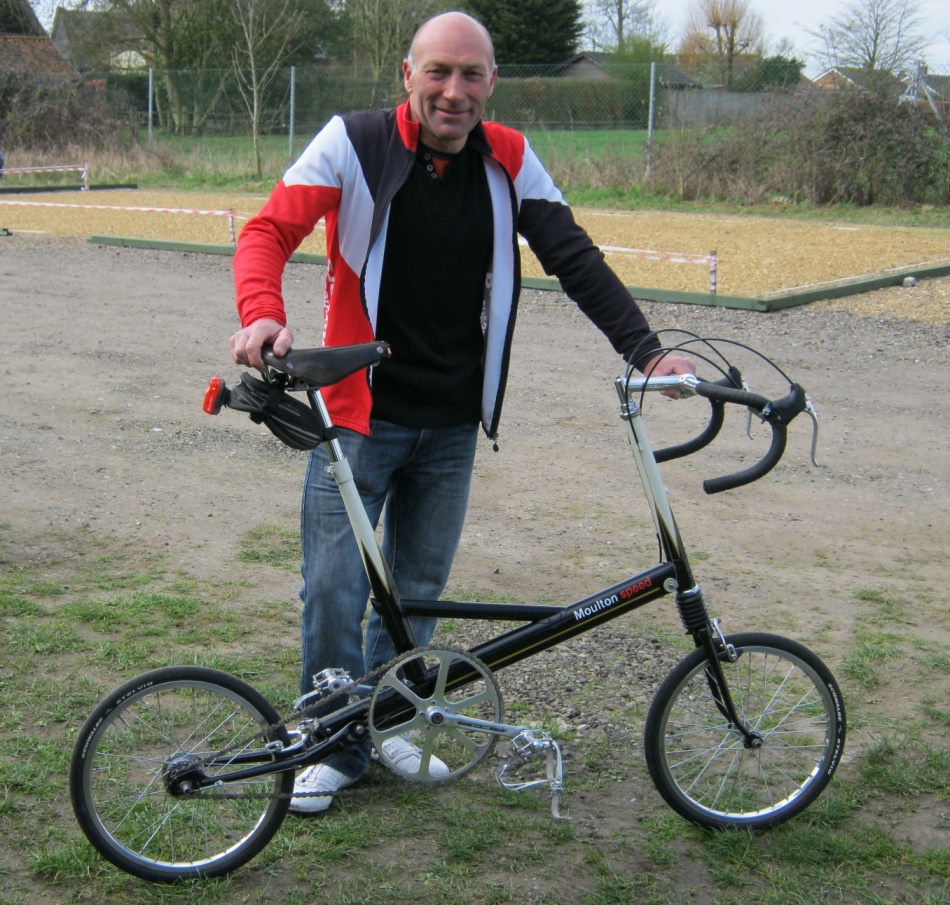
Their club, by the way, is Colchester Rovers CC, founded 1891 and still very active with a wonderful junior section – the club had a total of 15 riders in the Under 12 and Under 10 races at their recent Mistley cyclo-cross. The cakes at this annual event are really without rival in the cyclo-cross League and, although she has help now, Julie has been the person behind the tea-counter for as long as I can remember.
Mike Baker
I have used the Simplex Retrofriction gear levers but I did find them a tight fit on Campagnolo bosses and had to file a little paint off the square part of the boss to make them a snug fit. Better tight than loose! (ED: mine slipped over the braze-on boss with no trouble.)
On the problem of downtube Campagnolo levers slipping at the critical moment, I used to fit a spring washer or serrated washer under the bolt which stopped it slipping and retained the lever at correct tension. I preferred the little wire wing nuts which you could adjust on the move, but they needed very little resetting when the washers were fitted.
Tony Jenkins has researched replacement bearings for Harden hubs:
As there was a little lateral movement in a Mercian rear wheel I ordered some new bearings then investigated.
As you can see from the photo the bearings on either side were different. Both are R&M a LNJ and a KLNJ. One, and the replacements I bought, have 7 balls, yet the “odd” one , which could well be an original has more balls, and on the other side filling slots to get them in.
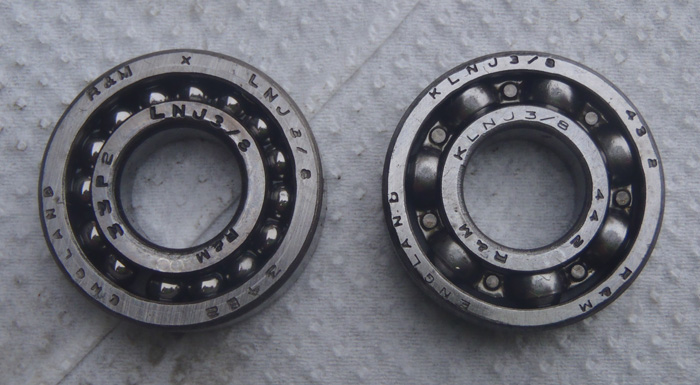
I’m no engineer, and it may be counterintuitive, but these look stronger. Considering the comment in Steve Griffiths book that these 7/32″ wide bearings were not up to the job, I’m wondering — were the originals stronger than the current replacements?
This has been niggling me so have looked into this a bit more and come to the following conclusions:-
1. The preferred bearing is LNJ 3/8, not the readily available and cheap KLNJ 3/8. Both are the same dimensions , it’s just the LNJ is packed with balls through a filling slot and therefore has a far greater load capacity.
2. If, as comments suggest, the original bearings were not up to the job, then it is likely Harden used the stronger LNJ’s (3 out of 4 on the Mercian were these). It may have been just availability and cost caused people to switch later to the cheaper KLNJ type.
3. I have just bought 4 x LNJ 3/8. They are expensive but still available as new/old stock if you look.
4. Both your classic website and others e.g. http://pardo.net/bike/pic/fail-024/000.html
have information on Harden.
Maybe Harden did use cheap bearings, which was the source of their problems / or an opportunity for servicing income — depending how you look at it! Either way the option now is to use bearings with a higher load rating (LNJ 3/8), or settle for the cheap ones (KLNJ 3/8) and change them more often.
I came across your website by chance and was amazed to find references to Hawkes of Stratford. When I was a lad about 14/15 years I had the bike craze (we all did because it was the only way to get out of east London into somewhere pleasant). Having saved up my money from a paper round, I bought my first true lightweight (in place of my Viking Ian Steel) from Lew Hawkes at the Leytonstone road shop. This would have been about 1954. My father knew Lew Hawkes well as he was also a trader in the area. Lew and I were great pals and he and Alice were very kind to me as a youngster.
That first bike was the business – of Reynolds 531 and with special lugwork which Lew did for me specially. You can take it from me that Hawkes at that time made their own frames (or at least some of them) and I personally watched Lew at work in his little workshop from time to time making my frame and others too. If I remember rightly the frame cost me £20 and I completed the bike with the best kit I could afford – it all ran out at about £55. Of course I wasn’t satisfied with just the one bike (I’ve always been greedy) and saved up for another.
I liked to ride fixed gear sometimes and other times gears so it seemed the answer. I had a good look round at other builders first – there were plenty in the area – for example Rivetts Cycles, Rory O’Brien, Lapebie, EG Bates, Ephgrave, Hobbs of Barbican and Condor. Condor were popular in our neck of the woods but there was much teeth-sucking about the curly Hetchins machines and Paris bikes were routinely laughed at. I came close to getting an Ephgrave but in the end stuck to Hawkes.
It is certainly the case that Lew was very popular and the shop at Leytonstone road was often full of enthusiasts just gassing and no-one minded if nobody bought anything. I used to do a bit of time trialling and when I started I was pretty fed up with my performance – not being very good. Once again the kindness and encouragement became evident. They were nice people.
As a matter of fact I still have both my bikes and until now it has not occurred to me to sell them but I suppose at age 74 with rheumatoid arthritis it is daft not to do so. I have no idea what they would fetch and a main concern would be to try and preserve them rather than have them broken up into different parts. There is mention on your website by a Mr Jack Greely of Billericay, Essex, about a collection of bikes by a Mr Yates, also of Billericay and I wonder if you could perhaps put me in touch with either of these gentlemen. By further coincidence here I might add that I myself lived within three miles of Billericay from 1972 till 2001.
(ED: it is amazing how often these reminisces start with “I bought my first bike with money saved from doing a paper round”. Back in the 50s loads of people had their daily, or evening, paper delivered by a lad from their local shop. Deliveries of milk and bread were the norm as well, often by horse and cart – this is why people had such thriving roses in the garden. No sooner had the horse opened his bowels than the gardener was out with his shovel. Rhubarb was another thriving crop!!)
If you want suggestions for a period-correct build for a 50s frame then here are suggestions from Mister Holdsworth himself, W F (Sandy) Holdsworth, taken from his 1952 brochure:
It is hard to argue with his selection of components although he would of course be quoting them from the items he listed in the company’s much sought after Aids to Happy Cycling which was the ‘bible’ for many cyclists in that era. We hung around cycle shops at the start of each year waiting for this booklet to be published and probably had it in our jersey pocket well into the season talking about little else at social get-togethers (until we discovered girls that is, but cycling acted as a very effective substitute for bromide at first).
Peter Underwood, editor, urgently needs a 10cm badged steel Cinelli stem in very good condition, e.g. chrome perfect, to complete a project. Willing to pay current market price subject to discussion. Could possibly consider an un-badged stem, but again in VGC. Please no rusty stems needing re-plating.
Would also exchange for any ‘goodies’ I have such as Simplex Competition front rod changer, Barelli pedals, etc with price adjustment either way.
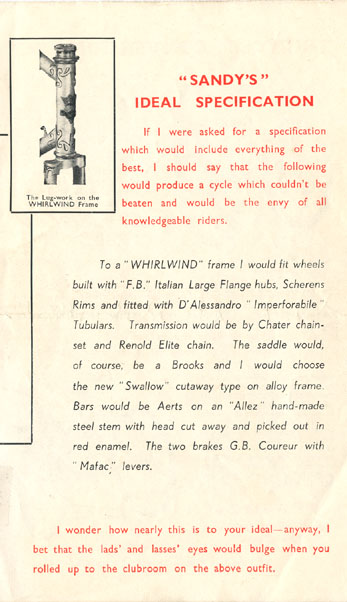
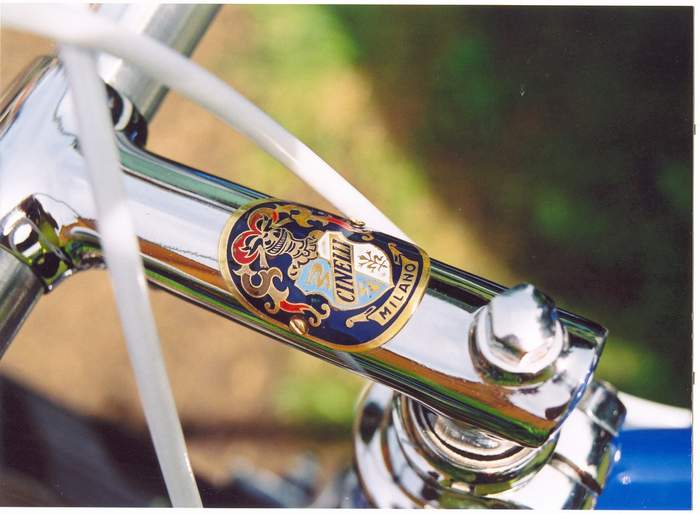
Toni Merkens was injured on the Russian front at Kharkov on 19/08/1943. He was struck between the heart and lungs from a Russian shell splinter. Then transferred to hospital in Mahrish-Ostran. He was repatriated back to Germany to Bad Wildbad in Baden Wurttemberg where he died from Meningitis on 05/02/1944.
In 1937 he rode a Hetchins in the Wembley 6-Day partnered with Gottfried Huertgen. They rode in bright red jerseys emblazoned with a black swastika. In the same race the American Jewish team of Louis Cohen and Jerry Rodman rode in the Stars and Stripes with a blue Star of David.
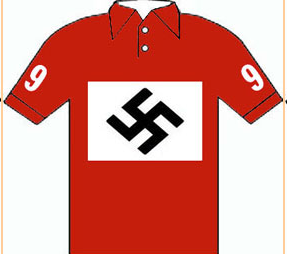
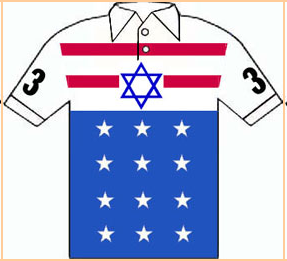
This was the only time the Swastika raced the Star of David and of course the Germans were riding on bicycle frames made by a Jewish firm.
Colin Myers:
I am currently restoring a 1948 Claud Butler, International Club. When acquired, this had an unusual mix of old/original parts and grotty, newer stuff. I am tempted to think that the brakes are original.
The calipers are marked “Balilla” in their earlier script on the left and more deeply stamped “G.B.London on the right. There is mention on your web site of Frejus/Balilla brakes from a similar period, but a different looking caliper!
Someone once mentioned to me that Geoff Burgess took over Balilla, or the U.K. Balilla importers.
As such he probably acquired some inventory, marked Balilla and the obvious move was to re-badge it. Contact:- candbmyers(at)btinternet.com
Stan Ayres
I have for sale a Claud Butler Anglo Continental C1937. The frame is very pretty with axe head cast lugs Claud Butler dropouts and belled out head tube. It has small dent on the top tube and a respray. The front forks may not be original. The frame is very streamlined with no braze-ons. There are double grease points on the bottom bracket and one on the head lug. Size is 55.5cma C-T and 57cms top tube C-C.
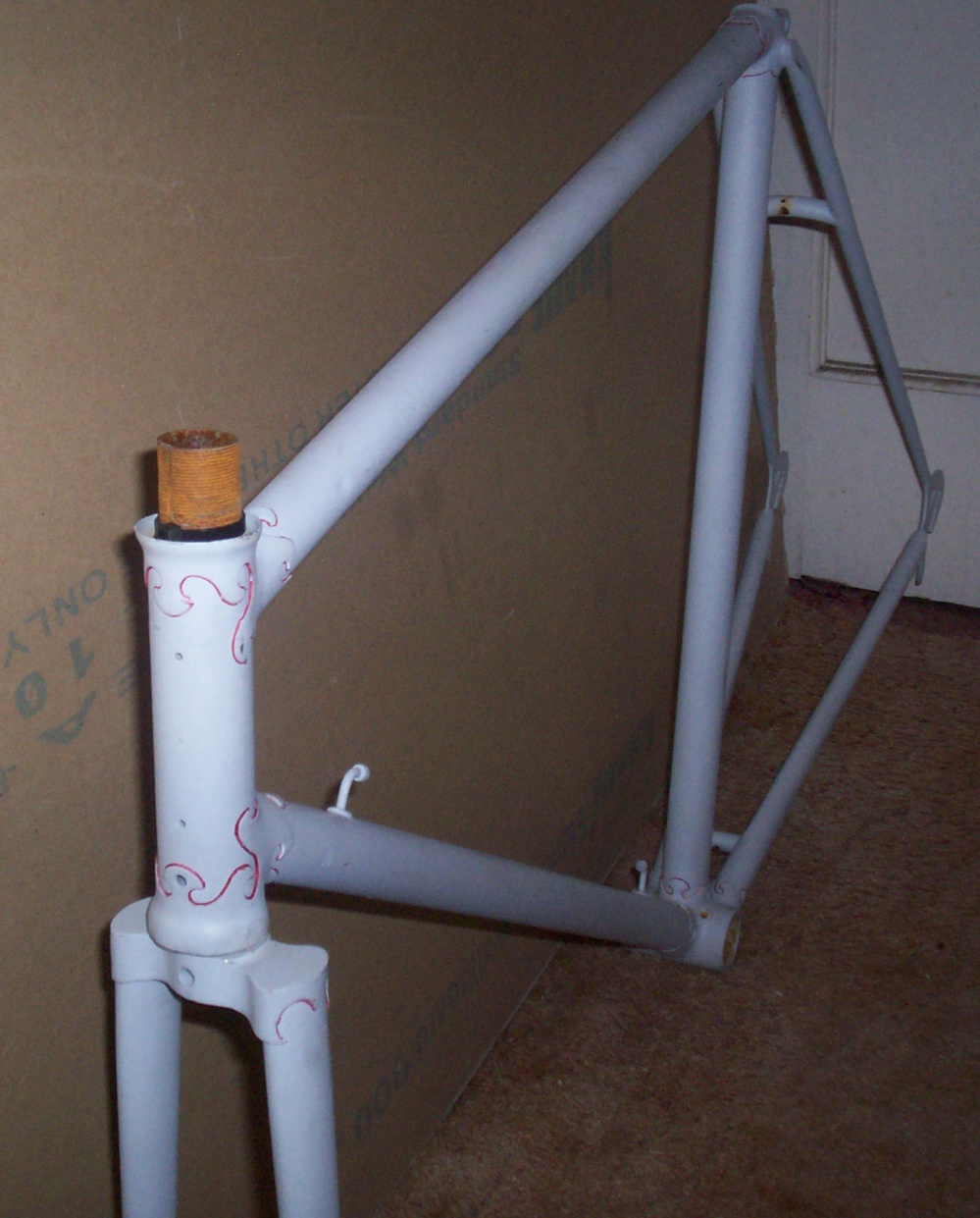
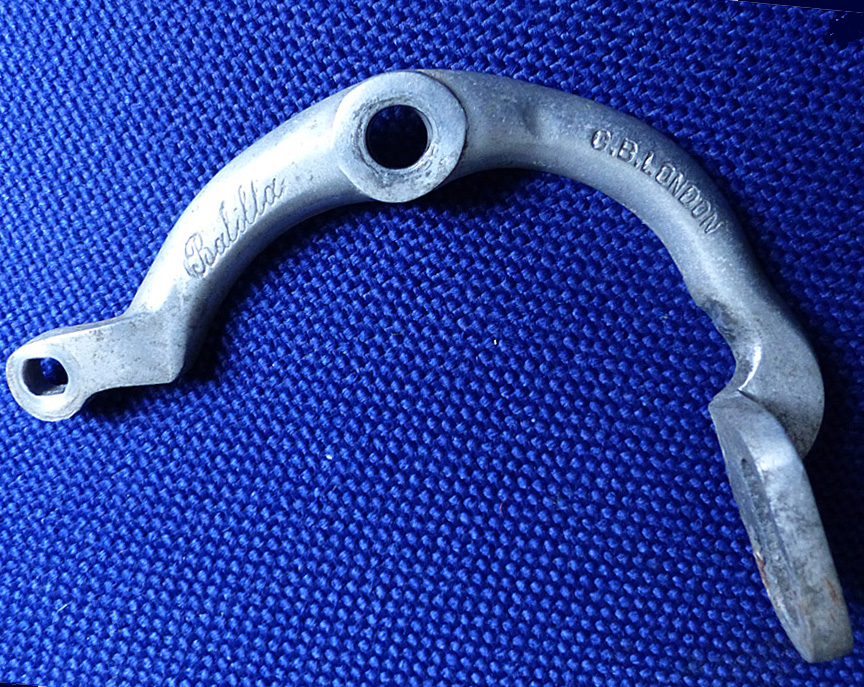
21 ½” (55cm) ‘Special Boisis’ Parisian racing bike 1940s, 531 butted tubing, original patina, 4 speed Osgear with rare alloy tension arm, LAM super course brakes, early Stronglight chainset, 46 t Durax ring, Lyotard pedals, early Christophe special toeclips, BIM saddle, Italian sprints on Porthor Super Course hubs, alloy wing nuts, AVA style stem, Maes bars. £600
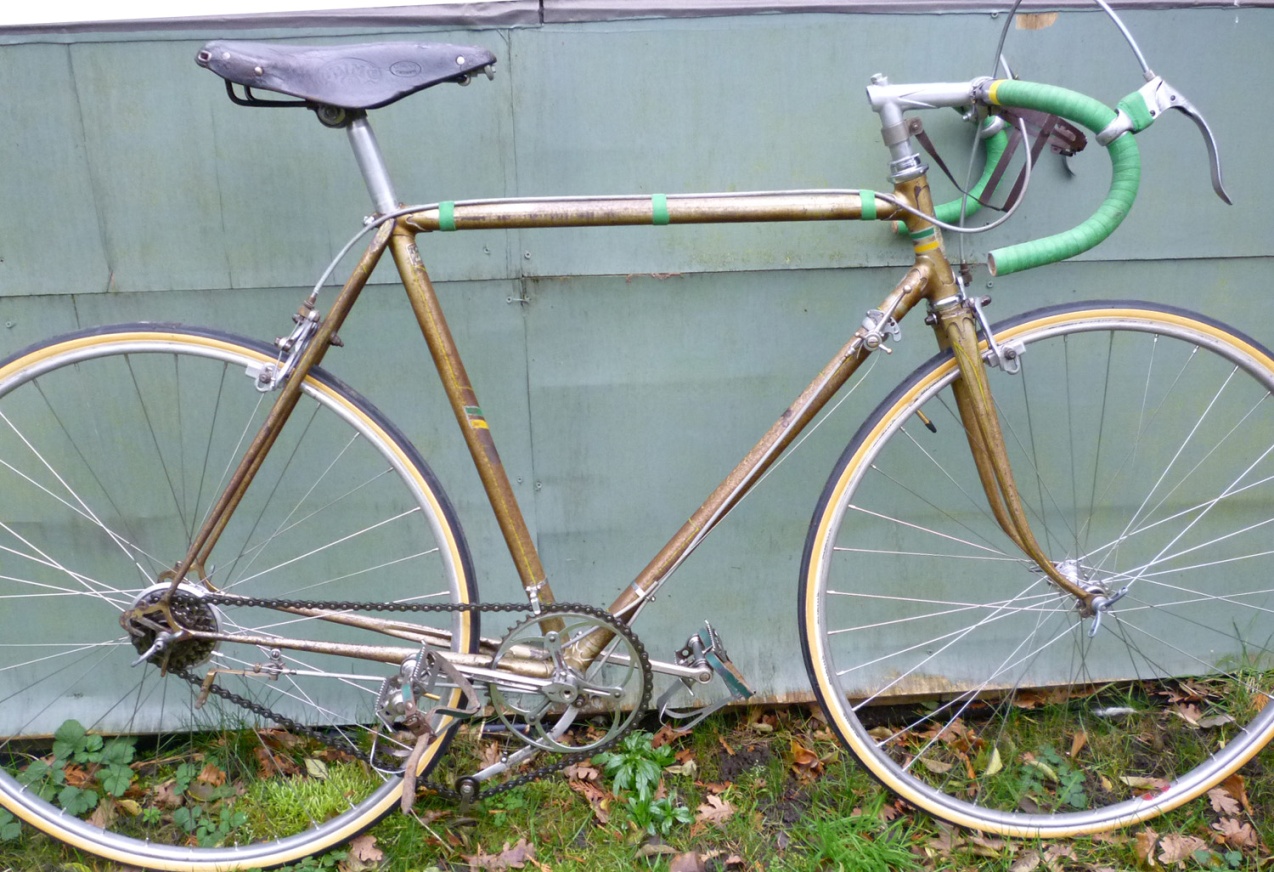
Also a: 22 ½” 1947 Macleans K800 ?’Club’ racing bike (sold to me as a Russ Anglo Continental retaining rare transfers), 4 speed Osgear, Docherty brakes, ?Stella cranks with Durax ring, Brampton B8 pedals, Zefal alloy toe clips, Mansfield North road saddle, Weinmann Alesa rims on large flange Airlites, original Dunlop special lightweight tyres in good order. (See image below) Bluemels Lightweight guards, Reynolds’ fancy lugged’ alloy stem with alloy ‘Marsh’ pattern bars. £700 (pump not included) Collection SE London Bryan Clarke clarkesharman@aol.com
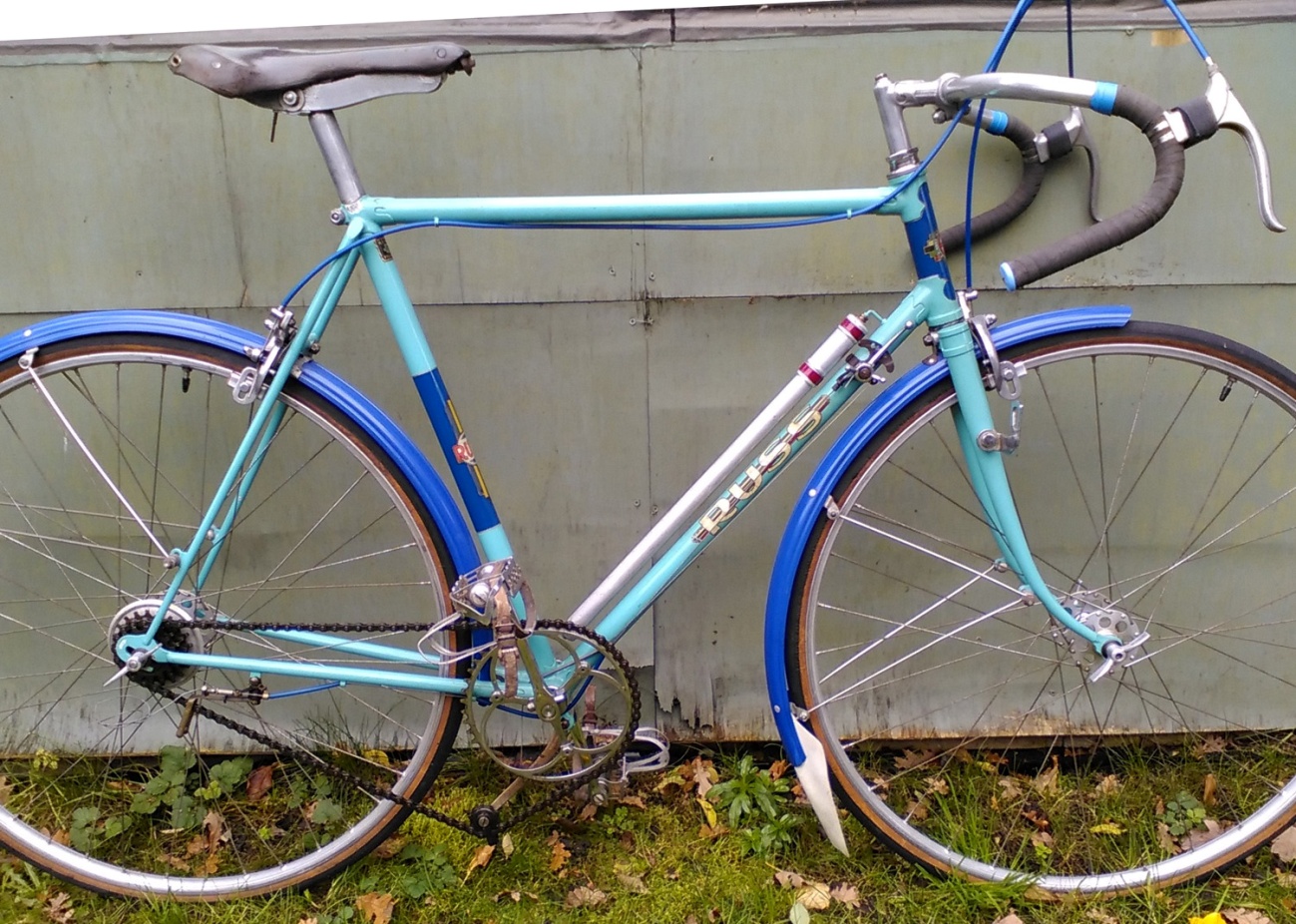
2016 Classic cycling quiz (50 marks)
(2 marks for each correct answer)
ANSWERS
1. b) 1946 (commencing in Cycling, February 6)
2. c) Swan (symbol of the former Buckinghamshire where Slough is situated)
3. c) Earls Court (winners: Danish pair Freddy Eugen/Palle Lykke)
4. c) Tom Simpson
5. d) Freddie Maertens (of the Belgian ‘Flandria’ team)
6. d) Wilier Triestina (distinctive copper-plated frames were its maker’s hallmark during this period)
7. a) GB
8. Vigorelli (stadium in Milan, Italy)
9. a) The leading British woman time triallist of the 1940s and1950s. [ b) Eileen Gray].
10. d) Giacinto Benotto was based in Turin (Benotto subsequently moved production to Mexico)
11. d) Christophe (a brand of toestraps)
12. b) Giro de Piemonte (the crash occurred on tramlines in the city centre of Turin)
13. d) Netherlands
14. b) Melbourne
15. d) Nine times (1953-1958; 1961; 1965-1966).
16. a) Tomorrow we ride [b) is the Reg Harris biography; c) the Barry Hoban biography]
17. b) Race organiser/team manager (including organising the British Milk Race which he notoriously repeatedly took the race ‘over the brown’ –i.e. the hilliest terrain).
18. c) 1975
19. b) 2 000 metres
20. e) Ruberg Kette (a brand of racing chain made in Germany)
21. d) Ephgrave. It is a small decoration brazed onto the cap on top of the seat stay
22. a) Rudi Altig (West Germany). He was UCI world pro road champion in 1966 having been second to Simpson in the 1965 race.
23. c) Syd Cozens (Cozens ordered Steel to wait for another rider in the mountains and, demoralised by futilely trying to save his exhausted team mate – Stan Jones – Steel retired from the race).
24. c) Audrey McElmury (1969 UCI women’s world road race title in Brno, Czechoslovakia, riding a Johnny Berry lightweight).
25. c) Cyril Horn.
SCORES
40–50: Congratulations! You are an aficionado
30–39: Well done, but …
20–29: Puncture prone
10–19: Ahem!
<10: You are in the broom wagon!
Posted: Friday 15th January 2016
This article appears in the following categories.
Upcoming Events
Whether you are looking for a gentle social meet up, or a 100-mile ride browse the community’s upcoming events and plan your next weekend outing.
